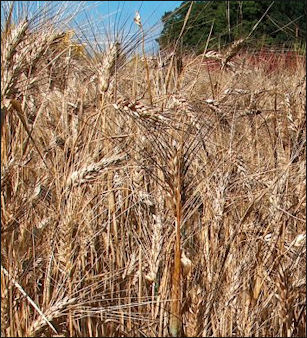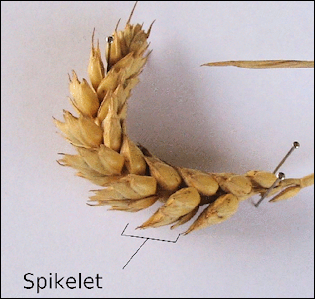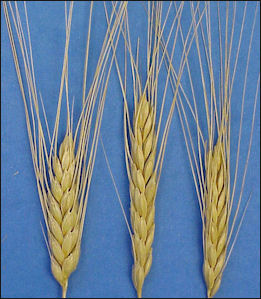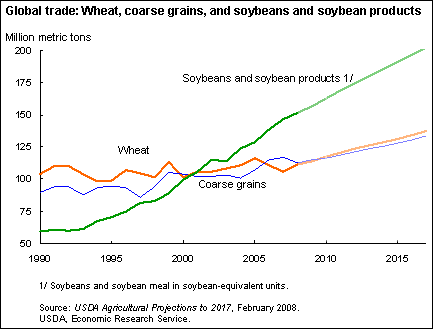WHEAT

Triticum durum wheat Wheat is one of the world's top food crops and one of the first to be cultivated. The development of wheat agriculture is credited with dividing the Stone Age from the age of civilized man. Today, wheat is the world’s No.2 dietary staple just behind rice but ahead of corn and bananas, accounting for 19 percent of all the calories that mankind consumes, compared to 20 percent for rice.
Wheat can easily be grown, handled and stored and keeps so well it can shipped anywhere and stored for years. It yields a large amount of food for its weight and can be used in making a wide variety of foods: bread in Germany, noodles in China, pasta in Italy, couscous in North Africa, and breakfast cereal in the United States.
Most wheat is divided into two types: hard wheat and soft wheat. Hard wheat such as durums are used to make pastas and soft wheats are used in pastries, noodles and mixed with other grains for bread. Soft wheats alone lack the stickiness to make bread and stiffness for pasta.
Websites and Resources: Wheatmania wheatmania.com ; Wikipedia article Wikipedia ; Wheat Foods Council wheatfoods.org ; Purdue University article hort.purdue.edu/newcrop/crops/wheat ; National Association of Wheat Growers wheatworld.org ; International Maize and Wheat Improvement Center cimmyt.org ;
First Crops, Einkorn and Emmer Wheat
The technique of dating starch granules found in cracks in rocks used to grind up plant material have has been used to find the earliest known use of several foods, including 23,000-year-old wheat discovered in Israel [Source: Ian Johnston, The Independent, July 3, 2017]
The first domesticated crop is believed to have been einkorn wheat, a kind of nourishing grass adapted from a wild species of grass native to the Karacadag mountains near Diyarbakir in southwestern Turkey first cultivated around 11,000 years ago. Scientists deduced this by examining the DNA of modern strains of einkorn wheat and found the were more similar to einkorn wheat grown in the Karacadag mountains than in other places. [Source: John Noble Wilford, New York Times, November 20, 1997]
Collecting seeds from wild grass is not an easy matter. If you pick the seeds before they are ripe they are too small and hard to eat. If you wait so long they fall from the stem and you have to pick them up one by one. With some grasses the period in which the seeds are feasible to collect is only a few days a year. If one wants to get a long term food supply it makes sense to collect as much as you can and take it back to your cave and store it.
Emmer wheat, rye and barley were cultivated around the same time, and is difficult to say which was cultivated first. Emmer wheat and another wheat strain from the Caspian Sea are thought to be the first bread wheats. Emmer wheat is a wild grass. It is thought to have been singled out because its seeds stay attached to the stem significantly longer than that of other grasses.
See Separate Articles: ORIGIN AND EARLY HISTORY OF AGRICULTURE factsanddetails.com FIRST GRAINS AND EARLIEST CROPS: BARLEY, EINKORN AND EMMER WHEAT, MILLET, SORGHUM, RICE AND CORN factsanddetails.com ; GRAINS factsanddetails.com
Wheat as Food

Beer making in ancient Egypt Barley, wheat and rye bear their seeds in spikes. Wheat grains (seeds) contains about 10 percent water, 14 percent protein, 2 percent fat , 2 percent ash and 72 percent carbohydrates. The protein, called gluten, is nutritious and provides a stickiness useful in trapping yeast and making bread. Most of the carbohydrates are in the form of starch.
A kernel of wheat is comprised of 83 percent endosperm, 15 percent bran and 2.5 percent wheat germ. The endosperm is used in making white flour. Bran is used in making whole wheat flour.
Bread can be made from almost anything — grains, potatoes, bananas, nuts — but wheat is most commonly used. All bread is either leavened or unleavened. Leavened means that it contains a substance such as yeast or baking soda that produces carbon-dioxide and causes the bread to rise and become light from air bubbles in the bread. Unleavened bread is hard and dry like matzo.
Hard wheats make a lighter bread than soft wheats because they are richer in gluten which traps more yeast.
Wheat Genome Sequenced
In 2010, British scientists announced that they had decoded the genetic sequence of wheat — one of the world’s oldest and most important crops. Wheat is grown across more of the world’s farmland than any other cereal. One academic in the field called the discovery “a landmark.” “The wheat genome is the holy grail of plant genomes,” said Nick Talbot, a professor of biosciences at the University of Exeter who wasn’t involved in the research. “It’s going to really revolutionize how we breed it.” [Source: Raphael G. Satter, Associated Press, August 27, 2010]
Associated Press reported: “University of Liverpool scientist Neil Hall, whose team cracked the code, said the information could eventually help breeders of varieties of wheat better identify genetic variations responsible for disease resistance, drought tolerance and yield. Although the genetic sequence remains a rough draft, and additional strains of wheat need to be analyzed for the work to be useful, Hall predicted it wouldn’t take long for his work to make an impact in the field. “Hopefully the benefit of this work will come through in the next five years,” he said.
“A genome is the full complement of an organism’s DNA, complex molecules which direct the formation and function of all living organisms. Sequencing an organism’s genome, gives unparalleled insight into how it is formed, develops and dies. Wheat is a relative latecomer to the world of genetic sequencing. This year marks the 10th anniversary of the date the human genome was laid bare. Other crops have had their genetic codes unscrambled within the past few years — rice in 2005, corn in 2009, and soybeans in 2010.
“The reason for the delay in analyzing wheat’s genetic code, Hall said, was that the code is massive — far larger than corn or rice and five times the length of the one carried by humans. One reason for the outsize genome is that strains such as the Chinese spring wheat analyzed by Hall’s team carry six copies of the same gene (most creatures carry two.) Another is that wheat has a tangled ancestry, tracing its descent from three different species of wild grass.
“But sequencing techniques have improved dramatically over the past decade. The process used in this case is called pyrosequencing, a technique which involves extracting DNA, suspending it in fluid, breaking it apart with bursts of gas and using chemical reactions and a high-resolution camera to infer its makeup. Hall said the machine used enabled his team to analyze a million strands of DNA at a time. The whole process took about a year to complete.
“Although the code may yet see use by genetic engineers hoping to craft artificial strains of wheat, Hall was at pains to stress the conventional applications of his work. Until now, breeders seeking to combine the best traits of two strains of wheat would cross the pair, grow the hybrid crop and hope for the best. Although the process has been used by farmers since wheat was first cultivated 10,000 years ago, Talbot described it as laborious and inefficient. “Very often we were talking about 10-15 years of intensive breeding programs,” he said. “We’re talking now about doing things in less than five.”
“Talbot noted that rice cultivation had already benefited from the publication of its genetic code — and led to the development of vitamin-enriched and drought-resistant strains. He said that his own field of specialty, the study of the destructive rice blast fungus, had been revolutionized as a result of having the genome sequence.”
Wheat Agriculture
Wheat is a member of the grass family and thus is very hardy. It grows well in areas with both plentiful rain and little rain but generally needs 400 mm of rain or irrigation water a year,. a cool and moist spring and hot and dry summer. The best soils for wheat are deep, well drained loams.

Wheat harvest Winter wheat is grown in places with mild winters. It is planted in the fall. After it takes root it stops growing until spring, when it starts growing again. It is harvested in the early summer with enough time to allow for the planting for another crop for the summer. Winter wheats originated in the Crimea area, north of the Black Sea.
In much of the world wheat agriculture is highly mechanized. After the ground is prepared with a tractor-pulled plough made up of steel disks, wheat is sown with mechanical sowers using both the broadcasting (scattering) and drilling methods. Wheat is resistant to most diseases and pests. Once it starts growing it needs little maintenance. Its tall, thin stems grow close together to keeps weeds out.
Timing is important for the harvest. If the wheat is cut too soon it will not keep well. If it is cut too late, the seeds will scatter in the harvesting process. In the old days wheat was harvested with a sickle. Now it is harvested with a mechanical cutter called a reaper.
After harvesting wheat chaff and stalks need to be winnowed from the grains. In the old days this was done by hand. Now it is done by machines called threshers. A combine is combination reaper and thresher that does both the cutting and threshing. The machines used to harvest and winnow wheat had a great impact on agriculture by reducing the number of people needed to work the fields.
New Strains Increase Wheat Yields While Diseases Reduce Them
Wheat agriculture is more productive than it used to be. A field of wheat that produced food for 5 people 750 years ago now produces food for between 20 and 50 people. Wheat yields in developing countries doubled between 1970 and 1995 thanks to Green Revolution seeds and technologies and wheat now vies with rice as the number one crop in the developing world.
New plant varieties and advances in agriculture have boosted wheat yields by nearly 80 percent. New wheat strains are resistant to heat, drought and pest and are more efficient at converting sunlight, water, and nutrients to grain. Wheat now grows in areas that were originally thought to be too arid and dry to raise crops. The down side of the trend towards widespread use of a few types of high-yield wheat strains has been to the disappearance and extinction of many other strains in a very short period of time. Only 10 percent of the 10,000 wheat varieties grown in China in 1949 are still in use.
Diseases such as a mutant form of stem rust can have a devastating impact. The reddish, wind-borne fungus — known to scientists as Ug99 — has ruined wheat crops in places such as Kenya, where up to 80 percent of the wheat in afflicted farmers’ fields have been affected. There are also serious concerns over climate change, water shortages and population growth. [Source: Raphael G. Satter, Associated Press, August 27, 2010]
Wheat, Biofuel and the Global Food Crises in 2008. 2010 and 2011
In 2008 food prices soared to such high levels that a global food crisis was declared. Between 2005 and the spring and summer of 2008 corn and wheat prices tripled and rice prices increased five-fold to $1,080 a ton. The price of all three grains soared 50 percent in just a few months. There were food riots in nearly two dozen countries, including Mexico, Burkina Faso, Senegal, and Morocco. The riots in Egypt, where wholesale rice prices doubled, were the worst in a generation. When wheat prices shoot up due to things like crop failures in Russia, import-dependent countries such as Egypt can be particularly hard hit.
Wheat prices suddenly rose 70 percent above normal levels in the summer of 2010 as the worst drought in decades devastated crops in the Black Sea region. Price then remained high into 2011. Prices for corn have more than doubled in 2010 months with global production unable to keep pace with record demand driven partly by the growth of the U.S. ethanol industry.
In September 2010, the Rome-based Food and Agriculture Organization eported that cereal production that year was the third-highest ever recorded, despite a drought-fueled wheat shortfall in Russia, and cereal stocks were high — some 100 million tons more than the low levels of 2007-2008, when some 38 countries shut down their food export markets in reaction. Increased demand for biofuels and soaring petroleum prices took much of the blame for the spiraling upward prices then. Food prices are still "stubbornly" high, but "we haven't seen the type of behavior .... panic buying" that helped feed the speculation and fears of a couple of years ago, said Josette Sheeran, the executive director of the U.N. World Food Program. [Source: Frances D'emilio, Associated Press, September 14, 2010]
Shifting the production of crops to make biofuel rather than food has caused prices of some food stuffs to soar. When American farmers began switching from wheat to corn and soy beans to meet biofuel demands in the 2000s, corn prices tripled. The price of wheat went up as the supply was reduced. Prices for soy beans also soared as demand for it as a source of fuel rose. The ramifications were on a global scale: food riots in Mexico over corn price hikes, increased beer prices at Munich’s Oktoberfest and high soy prices in China and Japan. With soy prices so high palm oil became an attractive alternative.
See Separate Article GLOBAL FOOD CRISIS factsanddetails.com
World’s Main Wheat Producing Countries

World’s Top Producers of Wheat (2020): 1) China: 134250000 tonnes; 2) India: 107590000 tonnes; 3) Russia: 85896326 tonnes; 4) United States: 49690680 tonnes; 5) Canada: 35183000 tonnes; 6) France: 30144110 tonnes; 7) Pakistan: 25247511 tonnes; 8) Ukraine: 24912350 tonnes; 9) Germany: 22172100 tonnes; 10) Turkey: 20500000 tonnes; 11) Argentina: 19776942 tonnes; 12) Iran: 15000000 tonnes; 13) Australia: 14480217 tonnes; 14) Kazakhstan: 14257950 tonnes; 15) Poland: 12433210 tonnes; 16) United Kingdom: 9658000 tonnes; 17) Egypt: 9000000 tonnes; 18) Spain: 8143510 tonnes; 19) Romania: 6754530 tonnes; 20) Italy: 6716180 tonnes ; [Source: FAOSTAT, Food and Agriculture Organization (U.N.), fao.org.
A tonne (or metric ton) is a metric unit of mass equivalent to 1,000 kilograms (kgs) or 2,204.6 pounds (lbs). A ton is an imperial unit of mass equivalent to 1,016.047 kg or 2,240 lbs.]
World’s Top Producers (in terms of value) of Wheat (2019): 1) China: Int.$31639710,000 ; 2) India: Int.$24534772,000 ; 3) Russia: Int.$17632686,000 ; 4) United States: Int.$12376211,000 ; 5) France: Int.$9616503,000 ; 6) Canada: Int.$7660977,000 ; 7) Ukraine: Int.$6718954,000 ; 8) Pakistan: Int.$5766588,000 ; 9) Germany: Int.$5461933,000 ; 10) Argentina: Int.$4608662,000 ; 11) Turkey: Int.$4499784,000 ; 12) Australia: Int.$4167643,000 ; 13) Iran: Int.$3978756,000 ; 14) United Kingdom: Int.$3842579,000 ; 15) Kazakhstan: Int.$2675392,000 ; 16) Poland: Int.$2559546,000 ; 17) Romania: Int.$2438672,000 ; 18) Egypt: Int.$2131477,000 ; 19) Italy: Int.$1596114,000 ; 20) Bulgaria: Int.$1496683,000 ; [An international dollar (Int.$) buys a comparable amount of goods in the cited country that a U.S. dollar would buy in the United States.]
Top wheat-producing countries in 2008: (first Production in $1000; second Production in metric tons, FAO): 1) China, 15805966 , 112463296; 2) India, 11671546 , 78570200; 3) United States of America, 9301602 , 68016100; 4) Russian Federation, 6670506 , 63765140; 5) Canada, 4462759 , 28611100; 6) France, 4388762 , 39001700; 7) Pakistan, 3023994 , 20958800; 8) Australia, 2653403 , 21420177; 9) Ukraine, 2618186 , 25885400; 10) Turkey, 2428920 , 17782000; 11) Germany, 2315299 , 25988565; 12) United Kingdom, 1666334 , 17227000; 13) Kazakhstan, 1378582 , 12538200; 14) Argentina, 1234294 , 8508156; 15) Egypt, 1012186 , 7977051; 16) Italy, 897733 , 8855440; 17) Romania, 895241 , 7180980; 18) Brazil, 877289 , 6027131; 19) Poland, 811707 , 9274920; 20) Iran (Islamic Republic of), 800547 , 7956647;
World’s Main Wheat Exporting Countries
World’s Top Exporters of Wheat (2020): 1) Russia: 37267014 tonnes; 2) United States: 26131626 tonnes; 3) Canada: 26110509 tonnes; 4) France: 19792597 tonnes; 5) Ukraine: 18055673 tonnes; 6) Australia: 10400418 tonnes; 7) Argentina: 10196931 tonnes; 8) Germany: 9259493 tonnes; 9) Kazakhstan: 5198943 tonnes; 10) Poland: 4689130 tonnes; 11) Romania: 4304783 tonnes; 12) Lithuania: 3979200 tonnes; 13) Bulgaria: 3223233 tonnes; 14) Latvia: 3011623 tonnes; 15) Hungary: 2979320 tonnes; 16) Czechia: 2497600 tonnes; 17) Slovakia: 1274123 tonnes; 18) Sweden: 1057894 tonnes; 19) India: 928684 tonnes; 20) Denmark: 804381 tonnes ; [Source: FAOSTAT, Food and Agriculture Organization (U.N.), fao.org]
World’s Top Exporters (in value terms) of Wheat (2020): 1) Russia: US$7918294,000; 2) United States: US$6318111,000; 3) Canada: US$6317889,000; 4) France: US$4528591,000; 5) Ukraine: US$3594217,000; 6) Australia: US$2698498,000; 7) Germany: US$2105865,000; 8) Argentina: US$2029494,000; 9) Kazakhstan: US$1137140,000; 10) Poland: US$1047399,000; 11) Romania: US$962465,000; 12) Lithuania: US$896645,000; 13) Bulgaria: US$698083,000; 14) Latvia: US$652979,000; 15) Hungary: US$599166,000; 16) Czechia: US$523218,000; 17) Slovakia: US$283381,000; 18) India: US$243067,000; 19) Sweden: US$240380,000; 20) Austria: US$190907,000
The worlds top exporters of wheat in 1991 were: 1) the U.S. 2) Canada, 3) France, 4) Australia, 5) Turkey, 6) Argentina, 7) the UK, 8) Germany, 9) Italy and 10) Saudi Arabia.
World’s Main Wheat Importing Countries

emmer wheat World’s Top Importers of Wheat (2020): 1) Indonesia: 10299702 tonnes; 2) Turkey: 9659186 tonnes; 3) Egypt: 9042583 tonnes; 4) China: 8151572 tonnes; 5) Italy: 7994396 tonnes; 6) Algeria: 7053568 tonnes; 7) Brazil: 6159926 tonnes; 8) Philippines: 6150375 tonnes; 9) Bangladesh: 6014980 tonnes; 10) Nigeria: 5902528 tonnes; 11) Morocco: 5521529 tonnes; 12) Japan: 5373862 tonnes; 13) Netherlands: 4296917 tonnes; 14) Spain: 4151810 tonnes; 15) Germany: 3999368 tonnes; 16) Belgium: 3852303 tonnes; 17) Mexico: 3726125 tonnes; 18) South Korea: 3709068 tonnes; 19) Vietnam: 3147629 tonnes; 20) Saudi Arabia: 3109457 tonnes ; [Source: FAOSTAT, Food and Agriculture Organization (U.N.), fao.org]
World’s Top Importers (in value terms) of Wheat (2020): 1) Egypt: US$2693851,000; 2) Indonesia: US$2616037,000; 3) Turkey: US$2334510,000; 4) China: US$2260233,000; 5) Italy: US$2039111,000; 6) Algeria: US$1828931,000; 7) Philippines: US$1573208,000; 8) Japan: US$1524539,000; 9) Nigeria: US$1483996,000; 10) Brazil: US$1459354,000; 11) Bangladesh: US$1439760,000; 12) Morocco: US$1426385,000; 13) South Korea: US$970454,000; 14) Netherlands: US$949463,000; 15) Spain: US$947506,000; 16) Germany: US$907414,000; 17) Mexico: US$901745,000; 18) Belgium: US$859193,000; 19) Vietnam: US$809252,000; 20) Thailand: US$778636,000
When wheat prices shoot up due to things like crop failures in Russia, import-dependent countries such as Egypt can be particularly hard hit. Droughts in 2006 sent wheat prices to record highs. Wheat production during the 2006-2007 cycle was 588 million tons, with a shortfall of almost 30 million from an expected demand of 607 million.
The worlds top importers of wheat in 1991 were: 1) the USSR, 2) China, 3) Italy, 4) Egypt, 5) Japan, 6) Brazil, 7) South Korea, 8) Algeria, 9) Iran, 10) Indonesia.
World’s Main Wheat Flour Exporting Countries
World’s Top Exporters of Wheat Flour (2020): 1) Turkey: 3070456 tonnes; 2) Kazakhstan: 1749315 tonnes; 3) Germany: 919747 tonnes; 4) Uzbekistan: 737054 tonnes; 5) Argentina: 615414 tonnes; 6) Egypt: 393680 tonnes; 7) Belgium: 356528 tonnes; 8) Italy: 335476 tonnes; 9) United States: 281302 tonnes; 10) India: 261849 tonnes; 11) Russia: 259056 tonnes; 12) France: 241531 tonnes; 13) Hungary: 230638 tonnes; 14) Spain: 227747 tonnes; 15) Ukraine: 225077 tonnes; 16) Canada: 205377 tonnes; 17) United Kingdom: 190883 tonnes; 18) China: 181284 tonnes; 19) Netherlands: 180870 tonnes; 20) Japan: 167373 tonnes ; [Source: FAOSTAT, Food and Agriculture Organization (U.N.), fao.org]
World’s Top Exporters (in value terms) of Wheat Flour (2020): 1) Turkey: US$983498,000; 2) Kazakhstan: US$491852,000; 3) Germany: US$359408,000; 4) Uzbekistan: US$218609,000; 5) Italy: US$215906,000; 6) Argentina: US$202322,000; 7) United States: US$154325,000; 8) India: US$146310,000; 9) Egypt: US$141831,000; 10) Canada: US$135624,000; 11) Belgium: US$132923,000; 12) France: US$122068,000; 13) United Kingdom: US$113588,000; 14) Spain: US$91334,000; 15) Netherlands: US$83007,000; 16) Russia: US$82866,000; 17) Japan: US$78171,000; 18) China: US$73556,000; 19) Hungary: US$73333,000; 20) Vietnam: US$70208,000
World’s Main Bulgur Exporting Countries
 Bulgur is a cereal food made from the cracked parboiled groats (whole grains) of several different wheat species, most often from durum wheat. It originates in West Asian cuisine.
Bulgur is a cereal food made from the cracked parboiled groats (whole grains) of several different wheat species, most often from durum wheat. It originates in West Asian cuisine.
World’s Top Exporters of Bulgur (2020): 1) United States: 18844 tonnes; 2) Belarus: 3652 tonnes; 3) Iraq: 38 tonnes; 4) Honduras: 12 tonnes; 5) Morocco: 12 tonnes; 6) Ghana: 11 tonnes; 7) Cote d’Ivoire: 10 tonnes; 8) Senegal: 5 tonnes; 9) Guinea: 1 tonne; 10) North Macedonia: 1 tonne; 11) Palestine: 1 tonne; 12) Cameroon: 1 tonne; [Source: FAOSTAT, Food and Agriculture Organization (U.N.), fao.org]
World’s Top Exporters (in value terms) of Bulgur (2020): 1) United States: US$7135,000; 2) Belarus: US$1473,000; 3) Iraq: US$41,000; 4) Ghana: US$22,000; 5) Morocco: US$20,000; 6) Honduras: US$12,000; 7) Côte d'Ivoire: US$4,000; 8) Palestine: US$4,000; 9) Senegal: US$3,000; 10) Guinea: US$3,000; 11) North Macedonia: US$2,000
World’s Main Buckwheat Producing and Exporting Countries
Despite its name, buckwheat is not closely related to wheat. It is not a cereal, nor is it even a member of the grass family. Buckwheat is related to sorrel, knotweed, and rhubarb.
World’s Top Producers of Buckwheat (2020): 1) Russia: 892160 tonnes; 2) China: 503988 tonnes; 3) Ukraine: 97640 tonnes; 4) United States: 86397 tonnes; 5) Brazil: 65117 tonnes; 6) Japan: 44800 tonnes; 7) Kazakhstan: 40094 tonnes; 8) Belarus: 28300 tonnes; 9) Tanzania: 25772 tonnes; 10) Nepal: 11724 tonnes; 11) Canada: 8900 tonnes; 12) Bhutan: 2701 tonnes; 13) South Korea: 1549 tonnes; 14) Bosnia and Herzegovina: 1301 tonnes; 15) South Africa: 234 tonnes; 16) Georgia: 118 tonnes; 17) Kyrgyzstan: 17 tonnes; 18) Republic of Moldova: 4 tonnes; [Source: FAOSTAT, Food and Agriculture Organization (U.N.), fao.org]
World’s Top Producers (in terms of value) of Buckwheat (2019): 1) Russia: Int.$250867,000 ; 2) China: Int.$137348,000 ; 3) Ukraine: Int.$27146,000 ; 4) United States: Int.$26892,000 ; 5) Brazil: Int.$20835,000 ; 6) Kazakhstan: Int.$14367,000 ; 7) Japan: Int.$13602,000 ; 8) Tanzania: Int.$7166,000 ; 9) Canada: Int.$5747,000 ; 10) Belarus: Int.$5415,000 ; 11) Nepal: Int.$3660,000 ; 12) Bhutan: Int.$750,000 ; 13) South Korea: Int.$619,000 ; 14) Bosnia and Herzegovina: Int.$237,000 ; 15) South Africa: Int.$73,000 ; 16) Georgia: Int.$37,000 ; 17) Republic of Moldova: Int.$7,000 ; [An international dollar (Int.$) buys a comparable amount of goods in the cited country that a U.S. dollar would buy in the United States.]
World’s Top Exporters of Buckwheat (2020): 1) Russia: 59157 tonnes; 2) United States: 14332 tonnes; 3) China: 13169 tonnes; 4) Poland: 12925 tonnes; 5) Lithuania: 11431 tonnes; 6) Latvia: 10012 tonnes; 7) Belarus: 8096 tonnes; 8) Kazakhstan: 7496 tonnes; 9) Canada: 6176 tonnes; 10) India: 3133 tonnes; 11) Netherlands: 3052 tonnes; 12) Brazil: 2827 tonnes; 13) Germany: 2571 tonnes; 14) Czechia: 1443 tonnes; 15) Estonia: 1436 tonnes; 16) France: 845 tonnes; 17) Pakistan: 837 tonnes; 18) Austria: 726 tonnes; 19) Hungary: 546 tonnes; 20) Belgium: 452 tonnes
World’s Top Exporters (in value terms) of Buckwheat (2020): 1) Russia: US$28959,000; 2) United States: US$10552,000; 3) China: US$9107,000; 4) Poland: US$8960,000; 5) Lithuania: US$7309,000; 6) Latvia: US$5767,000; 7) Canada: US$4402,000; 8) Kazakhstan: US$4293,000; 9) Netherlands: US$3529,000; 10) Belarus: US$3491,000; 11) Austria: US$2676,000; 12) Germany: US$2525,000; 13) Czechia: US$1490,000; 14) India: US$1380,000; 15) Brazil: US$1296,000; 16) Estonia: US$1282,000; 17) Italy: US$991,000; 18) France: US$713,000; 19) Hungary: US$420,000; 20) Belgium: US$415,000
World’s Main Buckwheat Importing Countries
World’s Top Importers of Buckwheat (2020): 1) Ukraine: 32226 tonnes; 2) Japan: 31784 tonnes; 3) Poland: 15567 tonnes; 4) Italy: 10760 tonnes; 5) Papua New Guinea: 10000 tonnes; 6) Malaysia: 8620 tonnes; 7) United States: 7563 tonnes; 8) France: 7158 tonnes; 9) Germany: 5875 tonnes; 10) Netherlands: 4593 tonnes; 11) Latvia: 4389 tonnes; 12) Georgia: 4198 tonnes; 13) Kazakhstan: 4109 tonnes; 14) Lithuania: 3881 tonnes; 15) Czechia: 3872 tonnes; 16) China: 3388 tonnes; 17) Belgium: 2697 tonnes; 18) Nepal: 2639 tonnes; 19) Estonia: 2522 tonnes; 20) United Kingdom: 2079 tonnes ; [Source: FAOSTAT, Food and Agriculture Organization (U.N.), fao.org]
World’s Top Importers (in value terms) of Buckwheat (2020): 1) Japan: US$22821,000; 2) Ukraine: US$14490,000; 3) Italy: US$8399,000; 4) Poland: US$7405,000; 5) United States: US$7025,000; 6) Papua New Guinea: US$6500,000; 7) France: US$5701,000; 8) Germany: US$5216,000; 9) Czechia: US$4883,000; 10) Netherlands: US$4387,000; 11) Mexico: US$3650,000; 12) Georgia: US$3085,000; 13) United Kingdom: US$2608,000; 14) Latvia: US$2578,000; 15) Malaysia: US$2372,000; 16) Estonia: US$2127,000; 17) Lithuania: US$1977,000; 18) Belgium: US$1935,000; 19) South Korea: US$1749,000; 20) Spain: US$1543,000
Image Sources: Wikimedia Commons
Text Sources: National Geographic, New York Times, Washington Post, Los Angeles Times, Smithsonian magazine, Natural History magazine, Discover magazine, Times of London, The New Yorker, Time, Newsweek, Reuters, AP, AFP, Lonely Planet Guides, Compton’s Encyclopedia and various books and other publications.
Last updated March 2022
